Ann Lethbridge's Blog, page 28
November 1, 2011
The Bankes's of Kingston Lacy
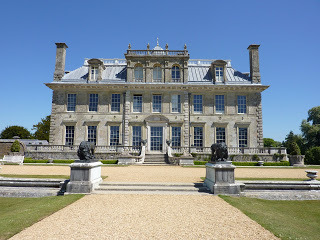 The Bankes family owned Kingston Lacy from around 1636 (at first known as Kingston Hall, the King part relating to its one time ownership by the King and the Lacy part from its medieval ownership by the de Lacys).
The Bankes family owned Kingston Lacy from around 1636 (at first known as Kingston Hall, the King part relating to its one time ownership by the King and the Lacy part from its medieval ownership by the de Lacys). The Bankes owned Corfe castle, not far away, which was eventually destroyed by Cromwellian forces and which was returned to the family in the restoration. They of course never lived there again and devoted all their attention to Kingston.
Since the period we are most interested in spans the long regency, I wanted to talk a bit about the two prime figures during that period. Sir Henry Banks, 1757 - 1834 and his son William Banks 1786-1855 who added many interesting artifacts to the house and whose travels and life were exceedingly interesting.
Sir Henry, having undertaken the grand tour, married a wealthy and beautiful woman, undertook major modernization of the house between 1784 and 1791. As mentioned in earlier posts, much of those changes were swept away in the 1830's by his son William, but we have looked at the parts that were in place during the regency. When the renovations were complete it was celebrated with a ball. Around 140 people danced from nine in the evening, sat down to supper at midnight and danced again until seven in the morning. Entertainment on the grand scale.
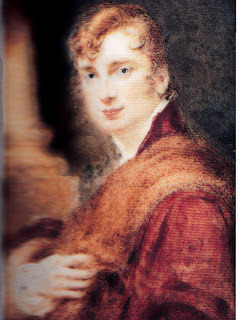 William was Sir Henry's second son. From Harrow, he went up to Trinity College, Cambridge in 1804 and became Lord Byron's (yes that Lord Byron) friend for life.
William was Sir Henry's second son. From Harrow, he went up to Trinity College, Cambridge in 1804 and became Lord Byron's (yes that Lord Byron) friend for life.He was one of the leading lights of the 1812 London season, something I must put in a book one of these days. This miniature was completed in that year by George Sandars in this year. During this year, he proposed to Annabella Milbanke, the bluestocking heiress who later married Byron. It was William who gave her his copy of Childe Harold. She married Byron in 1815.
In the meantime, William followed in Byron and William Beckford's footsteps traveling to Portugal and Spain in 1812 and spending two years there acquiring paintings and living the Bohemian life. He also served as an Aide de Camp to Wellesley (Later the Duke of Wellington) during this time.
He went from there to Egypt and then to Italy in 1814 and back to Egypt in 1815. Kingston Lacy houses one of the sole surviving gentleman's collection from the early days of British Egyptology. More about this to come. Until then Happy Rambles.
Published on November 01, 2011 20:01
October 5, 2011
Kingston Lacy
What was it like for the servants in these great house. Kingston Lacy provides us with a very interesting view.
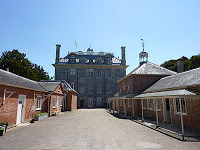
 Those outbuildings in an earlier post and which I repeat here, the laundry and drying room to the south (right) were designed and built in 1775-76. While the the Kitchens, sculleries and store rooms to the north were enlarged in the 1780s. Interesting that the food was prepared outside the main house, and as was usual in these days, it was probably for fire prevention purposes.
Those outbuildings in an earlier post and which I repeat here, the laundry and drying room to the south (right) were designed and built in 1775-76. While the the Kitchens, sculleries and store rooms to the north were enlarged in the 1780s. Interesting that the food was prepared outside the main house, and as was usual in these days, it was probably for fire prevention purposes.
 In the basement of the house of course we find the cellars, in this picture you can see barrels and bottles. There is also a butler's silver cupboard and the family Muniment Room which housed the banks family archives.
In the basement of the house of course we find the cellars, in this picture you can see barrels and bottles. There is also a butler's silver cupboard and the family Muniment Room which housed the banks family archives.
Other servants rooms include a housekeeper's room which is now used to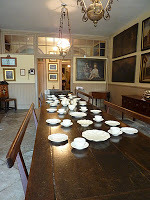 display the William Banks Egyptian collection. (More on William to come later) and leading off what is called the back hall is also the servants' hall pictured on the left. This lead out to the kitchen courtyard.
display the William Banks Egyptian collection. (More on William to come later) and leading off what is called the back hall is also the servants' hall pictured on the left. This lead out to the kitchen courtyard.
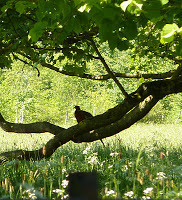
I thought you might enjoy this shot of a pheasant sitting on a tree branch in the grounds. Next time we will have some information about William Banks and his adventures.
Until next time, Happy Rambles.


 Those outbuildings in an earlier post and which I repeat here, the laundry and drying room to the south (right) were designed and built in 1775-76. While the the Kitchens, sculleries and store rooms to the north were enlarged in the 1780s. Interesting that the food was prepared outside the main house, and as was usual in these days, it was probably for fire prevention purposes.
Those outbuildings in an earlier post and which I repeat here, the laundry and drying room to the south (right) were designed and built in 1775-76. While the the Kitchens, sculleries and store rooms to the north were enlarged in the 1780s. Interesting that the food was prepared outside the main house, and as was usual in these days, it was probably for fire prevention purposes. In the basement of the house of course we find the cellars, in this picture you can see barrels and bottles. There is also a butler's silver cupboard and the family Muniment Room which housed the banks family archives.
In the basement of the house of course we find the cellars, in this picture you can see barrels and bottles. There is also a butler's silver cupboard and the family Muniment Room which housed the banks family archives.Other servants rooms include a housekeeper's room which is now used to
 display the William Banks Egyptian collection. (More on William to come later) and leading off what is called the back hall is also the servants' hall pictured on the left. This lead out to the kitchen courtyard.
display the William Banks Egyptian collection. (More on William to come later) and leading off what is called the back hall is also the servants' hall pictured on the left. This lead out to the kitchen courtyard.
I thought you might enjoy this shot of a pheasant sitting on a tree branch in the grounds. Next time we will have some information about William Banks and his adventures.
Until next time, Happy Rambles.
Published on October 05, 2011 21:04
October 2, 2011
Kingston Lacy
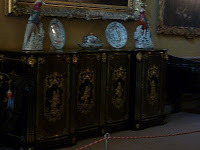 There are any number of amazing pieced of furniture at Kingston Lacy. Here are a few pieces from the rooms we visited..
There are any number of amazing pieced of furniture at Kingston Lacy. Here are a few pieces from the rooms we visited..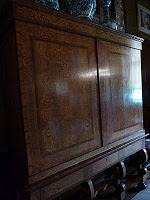
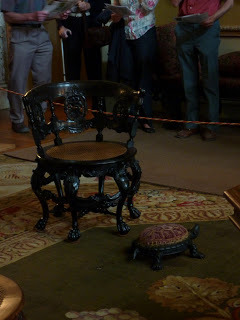
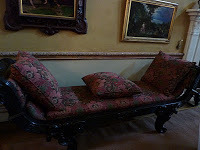
A great many renovations took place in the house after the Regency era and so as I pick and choose through my photographs I try to find things which come either during or before that era. However, the house is full of charm and interest so I err of including some things which come later.
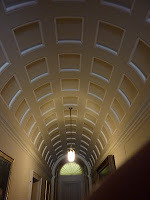
This ceiling in the upstairs hallway which leads to several bedrooms does date from the first renovation of the house in the 17 eighties. It is a barrel vault and coffered ceiling. The architect also made very clever use of natural light with his fan lights and cupola.
 The bedrooms set aside for bachelor bedrooms on the south and east sides, the servants being on the north side, are dated from 1834-41, but continue the fashion of Empress Josephine's Malmaison near Paris and the Charlotenhof at Potsdam, in that they are Tent Rooms. They are fascinatingly whimsical.
The bedrooms set aside for bachelor bedrooms on the south and east sides, the servants being on the north side, are dated from 1834-41, but continue the fashion of Empress Josephine's Malmaison near Paris and the Charlotenhof at Potsdam, in that they are Tent Rooms. They are fascinatingly whimsical.One of my pictures of a portrait which was Regency also reflects back the room behind me giving a good idea of the style and design. I honestly think anyone staying in these rooms must have felt quite suffocated.
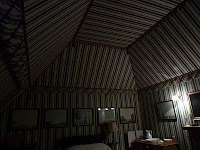
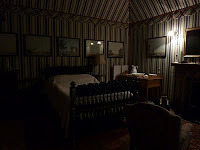
I do apologize for the darkness of these pictures, but flash is a no no, and who am I to disobey the rule.
Once more I find myself frustrated at the slowness of blogger's picture loading and while I do so hate to whine, I just can't take it anymore today. I have stories to write and heaven help me, some laundry awaiting my attention too.
Hah, glad to get that off my chest. lol Before we leave Kingston Lacy entirely, we have the ever fascinating servants' quarters to visit. Much more fascinating to me, I might add, since I have taken on and Upstairs Downstairs themed novel about which you will be hearing more in due course. And I did want to talk a bit about William Banke's adventures during the Regency era.
Until next time, Happy Rambles.
Published on October 02, 2011 10:41
September 26, 2011
Kingston Lacy
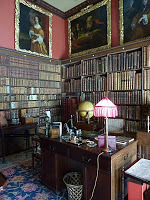
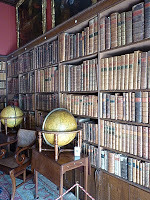
Kingston Lacy was originally built in 1660, and remained in the Bankes family until 1981. Henry Bankes the Younger was the first of the Bankes's to transform the house. This was in the 1780s, so of interest to us. All that remains from that renovation are the Library and the saloon, with the chimney piece by Flaxman and the coved ceiling painted by Cornelius Dixon. He was the owner of the house during the Regency, but much of the changes he wrought were swept away by his second son William when he came into the title in 1834.
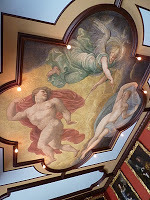
Here you have pictures of the library. Isn't that
a magnificent ceiling. I like the way the
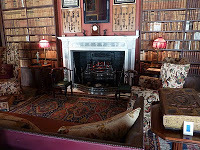 portraits hang above the book shelves.
portraits hang above the book shelves.The furnishings are also beautiful and deserve a closer look.
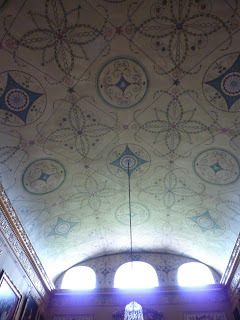
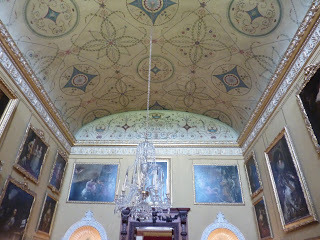
And here is that deliciously coved Venetian Ceiling. There is much more to come about the house, but there is a person I wanted to tell you about also.
William Bankes (1786-1855) was fascinating to me, not because of what he did at the house, but because of what he was doing during the Regency. A friend of Byron and a disappointed suitor of Annabella Milbanke, this young man began traveling when he was 26 in 1812, remember the Peninsular war was still going on then. He traveled to Portugal and Spain where he spent his time acquiring paintings and visiting with gypsies. Though he did also visit Wellington's headquarters after the battle of Salamanca in July 1812.
He travelled in the east for eight years. We will talk about his travels there next time. And also continue our stroll around Kingston Lacy.
Until then Happy Rambles.
Published on September 26, 2011 00:00
September 22, 2011
Here is the cover for my next Mills and Boon novel, Lady ...
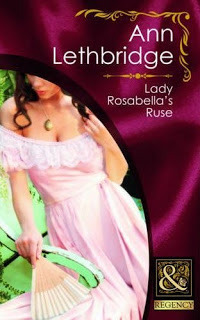 Here is the cover for my next Mills and Boon novel, Lady Rosabella's Ruse.
Here is the cover for my next Mills and Boon novel, Lady Rosabella's Ruse.This version comes out in the UK in November. It will also be out in North America at the end of December and is, I believe considered a January book. The thing is, will it be the same cover, or something completely different? It is nice to be surprised, but I must say I do like this cover.
Can you tell that we start off at a country house party?
For those of you who read the Rake's Inherited Courtesan and wrote to me about Garth, the brother of that book's hero, well here is the only woman who could possible bring that man to his knees.
If you are wondering what I have been up to recently, well the end of summer seemed to bring all kinds of busyness, and I have been working hard on a new project.
You will be hearing lots about it over the coming months, but it is an Upstairs Downstairs continuity series of 8 books written by eight different authors around the same family and --- naturally --- their servants. Lots of scandal and lots of fun.
And I still have lots of pictures to share and lots of fashion to talk about, so keep coming back!
Published on September 22, 2011 19:21
September 5, 2011
Kingston Lacy
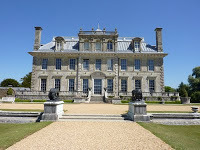
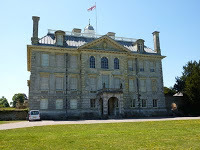 It is always a pleasure to visit one of Britain's stately home. Kingston Lacy was a delight. You may recall me refering to it in a flora and fauna posting about the bustard a bird that was extinct in in Britain since 1832 but is now being reintroduced.
It is always a pleasure to visit one of Britain's stately home. Kingston Lacy was a delight. You may recall me refering to it in a flora and fauna posting about the bustard a bird that was extinct in in Britain since 1832 but is now being reintroduced. The first manor was granted to John de Lacy, 1st Earl of Lincoln in 1229. The current house was build in 1665, but6 the original brick was faced in stone and underwent significant remodeling in 1835, including the addition of a chimney in each corner of the house.
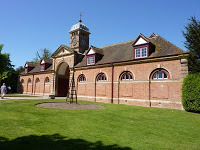
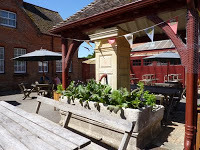 This was the stable block, now a restaurant but you can get an idea of what it would have been like when horses were the main mode of transport.
This was the stable block, now a restaurant but you can get an idea of what it would have been like when horses were the main mode of transport.This is a pump and horse trough and in the background you can see the entrance to the stables.
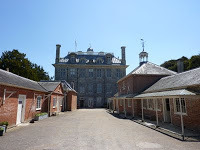
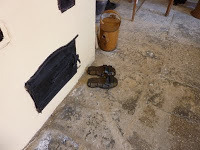 And here are some of the working outbuildings, laundry etc.
And here are some of the working outbuildings, laundry etc.The pattens on the flagstone floor are a nice touch, don't you think
Still lots more to see both of the house and the grounds. But until next time, Happy Rambles.
Published on September 05, 2011 20:06
August 22, 2011
Regency Fashion 1811
What were they wearing in the summer of the first year of the Regency?
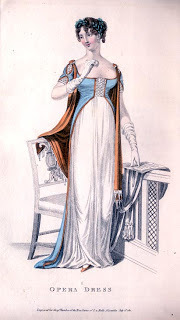
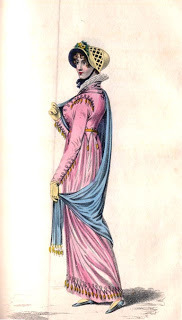
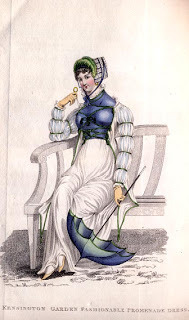
Here we have three gowns from June and July 1811. The first two are walking dresses and the last an opera dress. All show the classic regency lines.
Here are the general observations for July 1811 printed in the June edition of La Belle Assemblee:
Muslin pelisses, lined with pink, blue, or yellow sarsnet, are still very prevailing, as are spensers of like colours; lace scarfs alone seem to have the preference, either in black or white lace; mantlets are by no means considered as inelegant. Satin tippets, trimmed with lace, are very becoming to a light figure. White satin spensers, mantles, and pelisses are in a high degree of estimation. Small caps formed of brocaded ribband, finished with a long rosette in front, edged with lace pearls; or in the long Mango shape, intersected with white gymp, with a cord and tassels suspended from one side; and caps in every fanciful intermixture of satin or ribband, ornamented with ostrich feathers; they are made flat on the head, raised from the forehead, and in the long Grecian shape.
Flowers were not at all worn at the Prince's Fete, cords and tassels terminated the draperies, and gave an air of graceful negligence to the figure; feathers were universal, much of the Spanish costume prevailed; the sleeves were worn very short, the bosoms very low, the backs rather high, trains of a moderate length. The tunic in crape or lace, embroidered in silver, was displayed upon almost every female of rank and taste; this form of dress will of course descend to the morning habit, and will doubtless relieve the stomacher of much of that formal appearance which at present distinguishes it, and the effect will be extremely graceful. All lace worn on this magnificent occasion was of the manufacture of this country, a noble example, which we hope will be universally followed in all ranks of life. Honiton lace, as most resembling Brussel's point, held the preference.
The ornaments in jewellry were either of diamonds, pearls, rubies, sapphires, or emeralds.
The prevailing colours, pink, blue, yellow, and buff.
Until next time, Happy rambles




Here we have three gowns from June and July 1811. The first two are walking dresses and the last an opera dress. All show the classic regency lines.
Here are the general observations for July 1811 printed in the June edition of La Belle Assemblee:
Muslin pelisses, lined with pink, blue, or yellow sarsnet, are still very prevailing, as are spensers of like colours; lace scarfs alone seem to have the preference, either in black or white lace; mantlets are by no means considered as inelegant. Satin tippets, trimmed with lace, are very becoming to a light figure. White satin spensers, mantles, and pelisses are in a high degree of estimation. Small caps formed of brocaded ribband, finished with a long rosette in front, edged with lace pearls; or in the long Mango shape, intersected with white gymp, with a cord and tassels suspended from one side; and caps in every fanciful intermixture of satin or ribband, ornamented with ostrich feathers; they are made flat on the head, raised from the forehead, and in the long Grecian shape.
Flowers were not at all worn at the Prince's Fete, cords and tassels terminated the draperies, and gave an air of graceful negligence to the figure; feathers were universal, much of the Spanish costume prevailed; the sleeves were worn very short, the bosoms very low, the backs rather high, trains of a moderate length. The tunic in crape or lace, embroidered in silver, was displayed upon almost every female of rank and taste; this form of dress will of course descend to the morning habit, and will doubtless relieve the stomacher of much of that formal appearance which at present distinguishes it, and the effect will be extremely graceful. All lace worn on this magnificent occasion was of the manufacture of this country, a noble example, which we hope will be universally followed in all ranks of life. Honiton lace, as most resembling Brussel's point, held the preference.
The ornaments in jewellry were either of diamonds, pearls, rubies, sapphires, or emeralds.
The prevailing colours, pink, blue, yellow, and buff.
Until next time, Happy rambles
Published on August 22, 2011 09:00
August 18, 2011
Milling
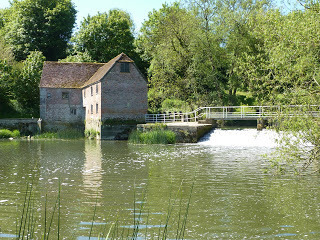 How did they do that?
How did they do that? You will have seen my earlier post on milling grain at Sturminster Newton, but I thought you might be interested in some views inside the mill itself.
As I may have mentioned before There has been a mill on this site for centuries. A predecessor may even have appeared in the doomsday book. The building is actually two separate mills. The one on the bank for grain, built in 1650 and the wing jutting into the river originally about 1611 (demolished in the 18th c and rebuilt in brick) was used for fulling. This is a method of cleaning the cloth from natural oils and dirt from the local cloth known as swanskin.
This is a small video of the mechanism which raised sacks of grain to the bin loft, with water power, and put into, you guessed it, grain bins. The mill now has a 1904 turbine engine but originally the power would have been produced by the water wheel attached to the mill.
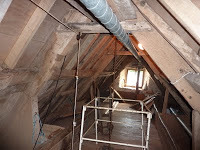
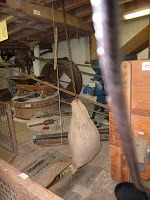 The sack of grain passes through the stone floor on its way to the bin loft above. Sacks were much larger than that used for the demonstration. These were west of England sacks weighing 18 stones (252 lbs) if it was wheat, 16 stones for barley and 12 stones for oats. Not easily carried up the very steep stairs.You can see the bins in the picture on the right, just and note that some of those roof beams are in the order of 600 or 700 years old, reused time and again. The bins are deliberately low-lipped so it was easier to pour the grain in by hand.
The sack of grain passes through the stone floor on its way to the bin loft above. Sacks were much larger than that used for the demonstration. These were west of England sacks weighing 18 stones (252 lbs) if it was wheat, 16 stones for barley and 12 stones for oats. Not easily carried up the very steep stairs.You can see the bins in the picture on the right, just and note that some of those roof beams are in the order of 600 or 700 years old, reused time and again. The bins are deliberately low-lipped so it was easier to pour the grain in by hand.The grain flowed down from the bins above via a chute, which was opened and closed by pushing wooden bats into a slot in the chute. The grain then passed through a winnower, a series of sieves to get rid of foreign materials. It went back down to the grainfloor (two stories down) where it was rebagged and hoisted up to the bins again where this time it would be directed to the mill stones.
The stone floor is between the ground floor or the grain floor and is where the grinding is done.
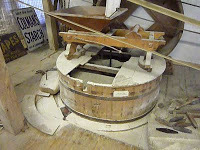 The grain falls into a hopper, supported by a horse, or wooden frame that is supported on a tun or vat, the tun being the large circular wooden box covering the stones. Grain from the hopper is fed into a wooden trough called a shoe, which vibrates and sends a steady stream of grain through a hole in the tun's surface into the millstones. A damsel, so called because of its chattering noise helps maintain the flow of grain.The grain is ground to flour between two millstones. The lower stone is static and is known as the bedstone. The moving stone is the runner. The flour finds its way out from under the runner, into the vat and finally down a hole and back to the ground floor to be bagged off. Bear in mind that all stone ground flour contains a little powdered stone and therefore the millstone must be a hard, fine-textured stone which wears to a smooth powder undetectable in the flour. Derbyshire or Peak stone was a popular choice for millstones. The French Buhr stone quarried near Paris was the very best of all.
The grain falls into a hopper, supported by a horse, or wooden frame that is supported on a tun or vat, the tun being the large circular wooden box covering the stones. Grain from the hopper is fed into a wooden trough called a shoe, which vibrates and sends a steady stream of grain through a hole in the tun's surface into the millstones. A damsel, so called because of its chattering noise helps maintain the flow of grain.The grain is ground to flour between two millstones. The lower stone is static and is known as the bedstone. The moving stone is the runner. The flour finds its way out from under the runner, into the vat and finally down a hole and back to the ground floor to be bagged off. Bear in mind that all stone ground flour contains a little powdered stone and therefore the millstone must be a hard, fine-textured stone which wears to a smooth powder undetectable in the flour. Derbyshire or Peak stone was a popular choice for millstones. The French Buhr stone quarried near Paris was the very best of all.When a stone wore down it would be the millers responsibility to dress the stones. He would remove all the wooden accessories, use a stone crane or winch, levers, wooden blocks etc to lift. to turn over and place the running stone on the floor. He would then mark the stones for dressing using a swan's feather dipped in raddle - an earth colour obtained from Cornwall or the Forest of Dean - then chip out the grooves and flatten the high spots with a steel pick held in a wooden handle called a bill or a thrift. Then he had to put it all back together. This could happen fairly often too. But the stones themselves could last as long as 0 years.
Mill stones vary but can weight up to three quarters of a tone each. They must be artificially roughened with grooves in order to grind rather than slide over the round grains as if they were ball bearings. A miller had to be careful not to let the stones grind against each other (run out of grain) or they might create a spark. Flour catches alight very easily and many mills burned down. This is the sound of the grain being turned into flour.
Hope you enjoyed our trip to the Mill at Stourbridge. Until next time, Happy Rambles
Published on August 18, 2011 02:00
August 14, 2011
More Old Devon
Since blogger seems to have fixed its picture facility I am going to try to post the rest of my Clovelly pictures.
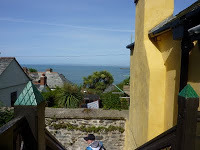
As you saw from the pictures last time, a fisherman's life is dangerous and hard work. But perhaps this view, taken from upstairs would help ease the pain.
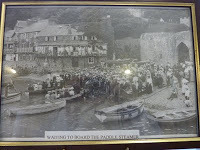 Clovelly has always been a tourist spot, and here you can see our Victorian visitors waiting to leave by paddle steamer. Do you see how much this picture resembles my pictures in the earlier blogs? It gives me the shivers a bit.
Clovelly has always been a tourist spot, and here you can see our Victorian visitors waiting to leave by paddle steamer. Do you see how much this picture resembles my pictures in the earlier blogs? It gives me the shivers a bit.
A famous inhabitant of Clovelly was Charles Kingsley. A writer who was born in South Devon in 1819. So not quite a product of the Regency, but born during the period. He lived at Clovelly with his family (he had five siblings), when his father was the Rector from 1832 to 1836.
Kingsley returned time and time again to Clovelly, as place he called "the dear old Paradise" and his "inspiration" before he met his wife. The following pictures may account for that letter. I leave it up to you to decide.
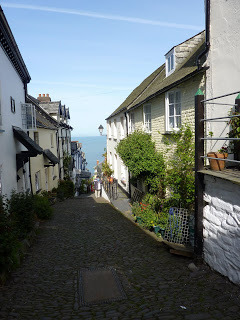
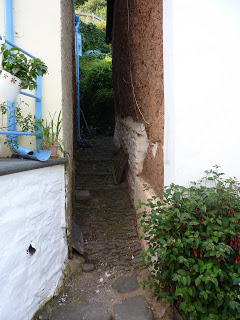
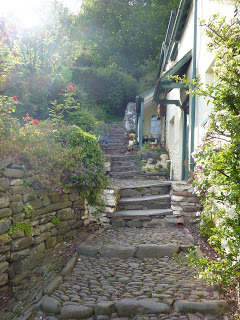
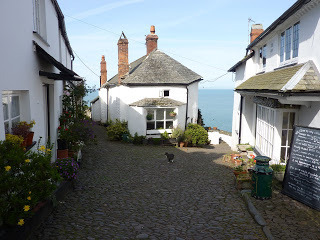

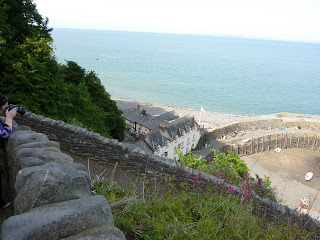
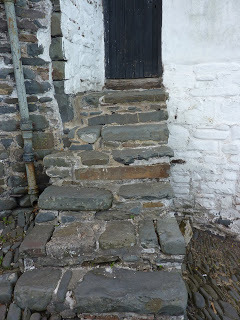
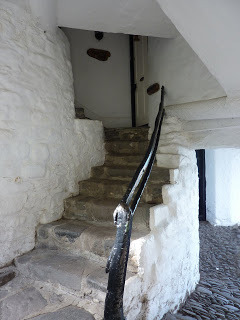
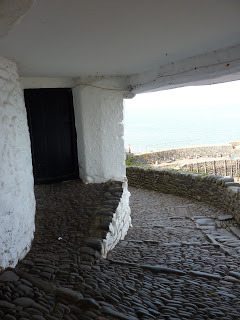
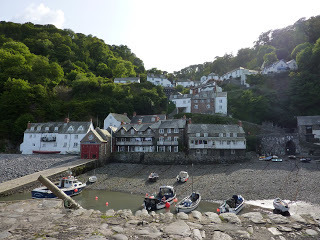
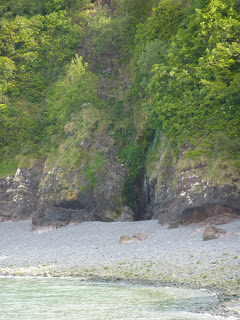
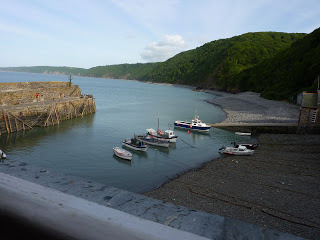
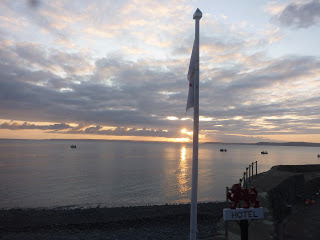
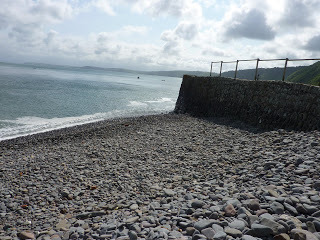
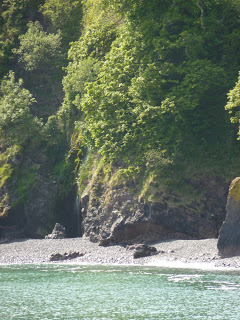 Until next time, happy rambles
Until next time, happy rambles

As you saw from the pictures last time, a fisherman's life is dangerous and hard work. But perhaps this view, taken from upstairs would help ease the pain.
 Clovelly has always been a tourist spot, and here you can see our Victorian visitors waiting to leave by paddle steamer. Do you see how much this picture resembles my pictures in the earlier blogs? It gives me the shivers a bit.
Clovelly has always been a tourist spot, and here you can see our Victorian visitors waiting to leave by paddle steamer. Do you see how much this picture resembles my pictures in the earlier blogs? It gives me the shivers a bit.A famous inhabitant of Clovelly was Charles Kingsley. A writer who was born in South Devon in 1819. So not quite a product of the Regency, but born during the period. He lived at Clovelly with his family (he had five siblings), when his father was the Rector from 1832 to 1836.
Kingsley returned time and time again to Clovelly, as place he called "the dear old Paradise" and his "inspiration" before he met his wife. The following pictures may account for that letter. I leave it up to you to decide.














 Until next time, happy rambles
Until next time, happy rambles
Published on August 14, 2011 21:28
August 10, 2011
RomCon 2011 and more
[image error]
If you are wondering what I have been up to. ie why I have been missing from here for a while, these are my excuses.
I had two stories to finish in the month of July. A Christmas Undone. Yep Christmas in July. I had to turn up the air conditioning to get in the mood.
I also had to hand in the follow up story to Captured for the Captain's Pleasure (Harlequin Historical) which came out in the UK in June 2010 and is coming out in North America in December 2011. (Yay) You know I only just found that out when I went on to Amazon. So fun.
which came out in the UK in June 2010 and is coming out in North America in December 2011. (Yay) You know I only just found that out when I went on to Amazon. So fun.
Anyway, the follow up book is about Alice's best friend Selena and is set in Scotland.
Last weekend I attended Rom Con 2011 in Denver Colorado. This is a conference for readers and I was honoured to meet so many readers of romance, to spend time with them, and have fun playing some hilarious games and talking about, you guessed it. Books!
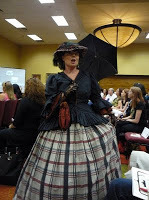
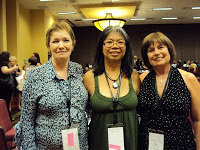
I really enjoyed the fashion show put on by Deanne Gist with a variety of authors modelling the costumes from the Victorian era. Here you can see me in my outfit a la Scarlett O'Hara. Lots of Fun
And here is myself and Mary Sullivan with reader Marelou, who so kindly sent me these pictures.
 And for the final piece de resistance (the words in italics are to be read with a French accent, tho' the spelling might be off they will sound correct).
And for the final piece de resistance (the words in italics are to be read with a French accent, tho' the spelling might be off they will sound correct).
This is me at the build a hero workshop and contest. Our group cheated as you can see. Words failed us, so we brought in the real thing! Now our group/table did win the prize, but that was because everyone was tied so we did a lucky dip. Our luck was in, in more ways than one.
That is all from me this evening. The pictures seem to be going better so I will get back to posting the last bits about Devon, before we move on to a new locale.
Until next time -- Happy Rambles
I had two stories to finish in the month of July. A Christmas Undone. Yep Christmas in July. I had to turn up the air conditioning to get in the mood.
I also had to hand in the follow up story to Captured for the Captain's Pleasure (Harlequin Historical)
 which came out in the UK in June 2010 and is coming out in North America in December 2011. (Yay) You know I only just found that out when I went on to Amazon. So fun.
which came out in the UK in June 2010 and is coming out in North America in December 2011. (Yay) You know I only just found that out when I went on to Amazon. So fun.Anyway, the follow up book is about Alice's best friend Selena and is set in Scotland.
Last weekend I attended Rom Con 2011 in Denver Colorado. This is a conference for readers and I was honoured to meet so many readers of romance, to spend time with them, and have fun playing some hilarious games and talking about, you guessed it. Books!


I really enjoyed the fashion show put on by Deanne Gist with a variety of authors modelling the costumes from the Victorian era. Here you can see me in my outfit a la Scarlett O'Hara. Lots of Fun
And here is myself and Mary Sullivan with reader Marelou, who so kindly sent me these pictures.
 And for the final piece de resistance (the words in italics are to be read with a French accent, tho' the spelling might be off they will sound correct).
And for the final piece de resistance (the words in italics are to be read with a French accent, tho' the spelling might be off they will sound correct).This is me at the build a hero workshop and contest. Our group cheated as you can see. Words failed us, so we brought in the real thing! Now our group/table did win the prize, but that was because everyone was tied so we did a lucky dip. Our luck was in, in more ways than one.
That is all from me this evening. The pictures seem to be going better so I will get back to posting the last bits about Devon, before we move on to a new locale.
Until next time -- Happy Rambles
Published on August 10, 2011 19:54



